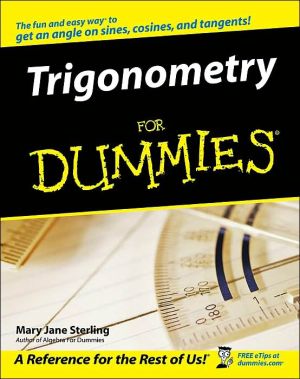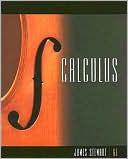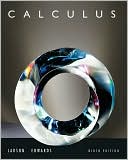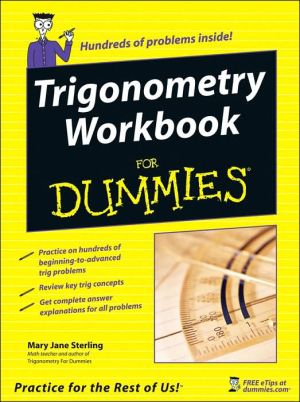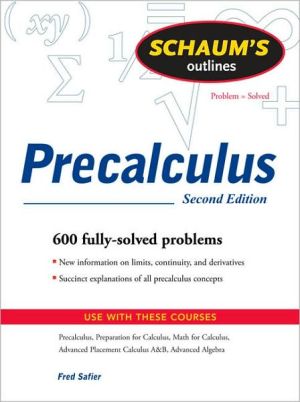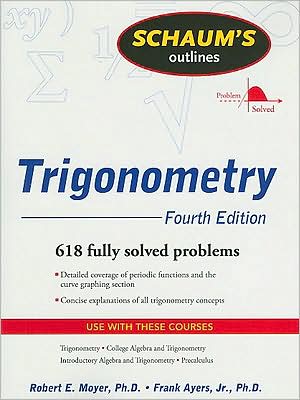Trigonometry for Dummies
A plain-English guide to the basics of trig From sines and cosines to logarithms, conic sections, and polynomials, this friendly guide takes the torture out of trigonometry, explaining basic concepts in plain English, offering lots of easy-to-grasp example problems, and adding a dash of humor and fun. It also explains the "why" of trigonometry, using real-world examples that illustrate the value of trigonometry in a variety of careers.\ Mary Jane Sterling (Peoria, IL) has taught mathematics...
Search in google:
A plain-English guide to the basics of trig From sines and cosines to logarithms, conic sections, and polynomials, this friendly guide takes the torture out of trigonometry, explaining basic concepts in plain English, offering lots of easy-to-grasp example problems, and adding a dash of humor and fun. It also explains the "why" of trigonometry, using real-world examples that illustrate the value of trigonometry in a variety of careers. Mary Jane Sterling (Peoria, IL) has taught mathematics at Bradley University in Peoria for more than 20 years. She is also the author of the highly successful Algebra For Dummies (0-7645-5325-9).
Trigonometry For Dummies\ \ By Mary Jane Sterling \ John Wiley & Sons\ ISBN: 0-7645-6903-1 \ \ \ Chapter One\ Trouncing Trig Technicalities\ In This Chapter\ * Understanding what trigonometry is\ * Speaking the language of trig\ * Putting it all into equations\ * Graphing for understanding\ How did Columbus find his way across the Atlantic Ocean? How did the Egyptians build the pyramids? How did early astronomers measure the distance to the moon? No, Columbus didn't follow a yellow brick road. No, the Egyptians didn't have Legos instructions. And, no, there isn't a tape measure long enough to get to the moon. The common answer here is trigonometry.\ Trigonometry is the study of angles and triangles and the wonderful things that you can do with them. For centuries, humans have been able to measure distances that they can't reach because of the power of this mathematical subject.\ Taking Trig for a Ride: What Trig Is\ "What's your angle?" That question isn't a come-on such as "What's your astrological sign?" In trigonometry, you measure angles in both degrees and radians. You can shove them into triangles and circles and make them do special things. Actually, angles drive trigonometry. Sure, you have to consider algebra and other math. But you can't have trigonometry without angles. Put an angle into a trig function, and out pops a special, unique number. What do you do with that number? Read on, because that's what trig is allabout.\ Sizing up the basic figures\ Segments, rays, and lines are some of the basic forms in geometry, and they're almost as important in trigonometry. As I explain in the following sections, you use those segments, rays, and lines to form angles.\ Drawing segments, rays, and lines\ A segment is a straight figure drawn between two endpoints. You usually name it by its endpoints, which you indicate by capital letters. Sometimes, a single letter names a segment, but a lowercase letter usually refers to an angle opposite that segment.\ A ray is another straight figure that has an endpoint on one end, and then it just keeps going forever in some specified direction. You name rays by their endpoint first and then by any other point that lies on the ray.\ A line is a straight figure that goes forever and ever in either direction. You only need two points to determine a particular line-and only one line can go through both of those points. You can name a line by any two points that lie on it.\ Intersecting lines\ When two lines intersect-if they do intersect-they can only do so at one point. They can't double back and cross one another again. Some curious things happen when two lines intersect. The angles that form between those two lines are related to one another. Any two angles that are next to one another and share a side are called adjacent angles. In Figure 1-2, the lines AB and CD intersect at point E. The two angles below the line CD (numbered 1 and 2) are adjacent to one another. So are the two angles to the right of line AB (numbered 2 and 3), the angles to the left of line AB (numbered 1 and 4), and the angles above line CD (numbered 3 and 4). So this intersection has four different pairs of adjacent angles.\ The angles that are opposite one another when two lines intersect also have a special name. Mathematicians call these angles vertical angles. They don't have a side in common. You can find two pairs of vertical angles in Figure 1-2, the pair of angles to the left and right (numbered 1 and 3), and the pair above and below (numbered 2 and 4).\ Why are these different angles so special? They're different because of how they interact with one another. The adjacent angles here are called supplementary angles. The sides that they don't share form a straight line, which has a measure of 180 degrees. The vertical angles are always equal in measure.\ Angling for position\ When two lines, segments, or rays touch or cross one another, they form an angle. In the case of two intersecting lines, the result is four different angles. When two segments intersect, they can form one, two, or four angles, depending on how they touch, as you can see in Figure 1-3. The same goes for two rays.\ These examples are just some of the ways that you can form angles. Geometry, for example, describes an angle as being created when two rays have a common endpoint. In practical terms, you can form an angle in many ways, from many figures. The business with the two rays means that you can extend the two sides of an angle out farther to help with measurements, calculations, and practical problems.\ You refer to the parts of all angles in the same way. The place where the lines, segments, or rays cross is called the vertex of the angle. From the vertex, two sides extend.\ Naming angles by size\ You can name or categorize angles based on their size or measurement in degrees (see Figure 1-4):\ \ Acute: An angle measuring between 0 and 90 degrees\ \ \ Obtuse: An angle measuring between 90 and 180 degrees\ \ \ Right: An angle measuring exactly 90 degrees\ \ \ Straight: An angle measuring exactly 180 degrees (a straight line)\ \ Naming angles by letters\ How do you name an angle? Why does it even need a name? In most cases, you want to be able to distinguish a particular angle from all the others in a picture. When you look at a photo in a newspaper, you want to know the names of the different people and be able to point them out. With angles, you should feel the same way.\ You can name an angle in one of three different ways:\ \ By its vertex alone: Often, you name an angle by its vertex alone because such a label is efficient, neat, and easy to read. In Figure 1-5, you can call the angle A.\ \ \ By a point on one side, followed by the vertex, and then a point on the other side: For example, you can call the angle in Figure 1-5 angle BAC or angle CAB. This naming method is helpful if someone may be confused as to which angle you're referring to in a picture. Remember: Make sure you always name the vertex in the middle.\ \ \ By a letter or number written inside the angle: Usually, that letter is Greek; in Figure 1-5, however, the angle has the letter w. Often, you use a number for simplicity if you're not into Greek letters or if you're going to compare different angles later.\ \ Triangulating your position\ All on their own, angles are certainly very exciting. But put them into a triangle, and you've got icing on the cake. Triangles are one of the most frequently studied geometric figures. The angles that make up the triangle give them many of their characteristics.\ Angles in triangles\ A triangle always has three angles. The angles in a triangle have measures that always add up to 180 degrees-no more, no less. A triangle named ABC has angles A, B, and ITLITL, and you can name the sides AB, BC, and AC, depending on which two angles the side is between. The angles themselves can be acute, obtuse, or right. If the triangle has either an obtuse or right angle, then the other two angles have to be acute.\ Naming triangles by their shape\ Triangles have special names based on their angles and sides. They can also have more than one name-a triangle can be both acute and isosceles, for example. Here are their descriptions, and check out Figure 1-6 for the pictures:\ \ Acute triangle: A triangle where all three angles are acute\ \ \ Right triangle: A triangle with a right angle (the other two must be acute)\ \ \ Obtuse triangle: A triangle with an obtuse angle (the other two must be acute)\ \ \ Isosceles triangle: A triangle with two angles that have the same measure; the lengths of the sides opposite those angles are equal, too\ \ \ Equilateral triangle: A triangle where all three angles measure 60 degrees; all the lengths of the sides are equal, too\ \ \ Scalene triangle: A triangle with no angles or sides of the same measure\ \ Circling the wagons\ A circle is a geometric figure that needs only two parts to identify it and classify it by size: its center (or middle) and its radius (the distance from the center to any point on the circle). Technically, the center isn't a part of the circle, it's just a sort of anchor or reference point. The circle consists only of all those points that are the same distance from the center.\ Radius, diameter, circumference, and area\ After you've chosen a point to be the center of a circle and know how far that point is from all the points that lie on the circle, you can draw a fairly decent picture. With the measure of the radius, you can tell a lot about the circle: its diameter (the distance from one side to the other, passing through the center), its circumference (how far around it is), and its area (how many square inches, feet, yards, meters-what have you-fit into it). Figure 1-7 shows these features.\ Ancient mathematicians figured out that the circumference of a circle is always a little more than three times the diameter of a circle. Since then, they narrowed that "little more than three times" to a value called pi (pronounced "pie"), designated by the Greek letter [pi]. The decimal value of pi isn't exact- it goes on forever and ever, but most of the time, people refer to it as being approximately 3.14 or 22/7, whichever form works best in specific computations.\ The formula for figuring out the circumference of a circle is tied to [pi] and the diameter.\ TRIG RULES\ Circumference of a circle: ITLITL = [pi]d = 2[pi]r\ The d represents the measure of the diameter, and r represents the measure of the radius. The diameter is always twice the radius, so either form of the equation works.\ Similarly, the formula for the area of a circle is tied to [pi] and the radius.\ TRIG RULES\ Area of a circle: A = [pi][r.sup.2]\ This formula reads, "Area equals pi are squared." And all this time, I thought that pies are round.\ Example: Find the radius, circumference, and area of a circle if its diameter is equal to 10 feet in length.\ If the diameter (d) is equal to 10, you write this value as d = 10. The radius is half the diameter, so the radius is 5 feet, or r = 5. You can find the circumference by using the formula ITLITL = [pi]d = [pi] x 10 [approximately equal to] 3.14 x 10 = 31.4. So the circumference is about 31 1/2 feet around. You find the area by using the formula A = [pi][r.sup.2] = [pi] x [5.sup.2] = [pi] x 25 [approximately equal to] 3.14 x 25 = 78.50, so the area is about 78 1/2 square feet.\ Chord versus tangent\ You show the diameter and radius of a circle by drawing segments from a point on the circle either to or through the center of the circle. But two other straight figures have a place on a circle. One of these figures is called a chord, and the other figure is a tangent.\ Chords of a circle\ A chord of a circle is a segment that you draw from one point on the circle to another point on the circle (see Figure 1-8). This segment always stays inside the circle. The largest chord possible is the diameter-you can't get any longer than that segment.\ Tangents to a circle\ A tangent to a circle is a line, ray, or segment that touches the outside of the circle in exactly one point, as in Figure 1-9. It never crosses into the circle. A tangent can't be a chord, because a chord touches a circle in two points, crossing through the inside of the circle.\ Sectioning sectors\ A sector of a circle is a section of the circle between two radii (plural for radius). You can consider this part like a piece of pie cut from a circular pie plate (see Figure 1-10).\ You can find the area of a sector of a circle if you know the angle between the two radii. A circle has a total of 360 degrees all the way around the center, so if a sector has an angle measure of 60 degrees between the two radii, the sector takes up 60/360, or 1/6, of the degrees all the way around. In that case, the sector has 1/6 the area of the whole circle.\ Example: Find the area of a sector of a circle if the angle between the two radii forming the sector is 80 degrees and the radius of the circle is 9 inches.\ 1. Find the area of the circle.\ The area of the whole circle is A = [pi][r.sup.2] = [pi] x [(4.5).sup.2] [approximately equal to] 3.14 x 20.25 = 63.585, or about 63 1/2 square inches.\ 2. Find the portion of the circle that the sector represents.\ The sector takes up only 80 degrees of the circle. Divide 80 by 360 to get 80/360 = 2/9 [approximately equal to] 0.222\ 3. Calculate the area of the sector.\ Multiply the fraction or decimal from Step 2 by the total area to get the area of the sector: 0.222 x 63.585 [approximately equal to] 14.116. The whole circle has an area of almost 64 square inches, but the sector has an area of just over 14 square inches.\ Understanding Trig Speak\ Any math or science topic has its own unique vocabulary. Some very nice everyday words have special meanings when used in the context of that subject. Trigonometry is no exception.\ Defining trig functions\ Every triangle has six parts: three sides and three angles. If you measure the sides and then pair up those measurements (taking two at a time), you have three different pairings. Do division problems with the pairings-changing the order in each pair-and you have six different answers. These six different answers represent the six trig functions. For example, if your triangle has sides measuring 3, 4, and 5, then the six divisions are 3/4, 4/3, 3/5, 5/3, 4/5, and 5/4. In Chapter 7, you find out how all these fractions work in the world of trig functions by using the different sides of a right triangle. And then, in Chapter 8, you take a whole different approach as you discover how to define the trig functions with a circle.\ The six trig functions are named sine, cosine, tangent, cotangent, secant, and cosecant. Many people confuse the spoken word sine with sign-you can't really tell the difference when you hear it unless you're careful with the context. You can "go off on a tangent" in some personal dealings, but that phrase has a whole different meaning in trig. Cosigning a loan isn't what trig has in mind, either. The other three ratios are special to trig speak. You can't confuse them with anything else.\ REMEMBER\ Interpreting trig abbreviations\ Even though the word sine isn't all that long, you have a three-letter abbreviation for this trig function and all the others. Mathematicians find using abbreviations easier, and those versions fit better on calculator keys. The functions and their abbreviations are\ \ sine [right arrow] sin\ \ \ cosine [right arrow] cos\ \ \ tangent [right arrow] tan\ \ \ cotangent [right arrow] cot\ \ \ secant [right arrow] sec\ \ \ cosecant [right arrow] csc\ \ As you can see, the first three letters in the full name make up the abbreviations, except for cosecant's.\ Noting notation\ Angles are the main focus in trigonometry, and you often don't know their measure. Many angles and their angle measures have general rules that apply to them. You can name angles by one letter, three letters, or a number, but to do trig problems and computations, mathematicians commonly refer to the angle measures with Greek letters.\ The most commonly used letters for angle measures are [alpha] (alpha), [beta] (beta), [gamma] (gamma), and [theta] (theta). Also, many equations use the variable x to represent an angle measure.\ TECHNICAL STUFF\ Algebra has conventional notation involving superscripts, such as the 2 in [chi square]. In trigonometry, superscripts have the same rules and characteristics as in other mathematics. But trig superscripts often look very different. Table 1-1 presents a listing of many of the ways that trig uses superscripts.\ (Continues...)\ \ \ \ \ Excerpted from Trigonometry For Dummies by Mary Jane Sterling Excerpted by permission.\ All rights reserved. No part of this excerpt may be reproduced or reprinted without permission in writing from the publisher.\ Excerpts are provided by Dial-A-Book Inc. solely for the personal use of visitors to this web site. \ \
Introduction. Part I: The Basics. Chapter 1: Trouncing Trig Technicalities. Chapter 2: Coordinating Your Efforts with Cartesian Coordinates. Chapter 3: Functioning Well. Chapter 4: Getting Your Degree. Chapter 5: Dishing Out the Pi: Radians. Chapter 6: Getting It Right with Triangles. Part II: Trigonometric Functions. Chapter 7: Doing Right by Trig Functions. Chapter 8: Trading Triangles for Circles: Circular Functions. Chapter 9: Applying Yourself to Trig Functions. Part III: Identities. Chapter 10: Trig’s Basic Identities. Chapter 11: Operating on Identities. Chapter 12: Proving Identities. Part IV: Equations and Applications. Chapter 13: Investigating Inverse Trig Functions. Chapter 14: Solving Trig Equations. Chapter 15: Obeying the Laws. Part V: The Graphs of Trig Functions. Chapter 16: Graphing Sine and Cosine. Chapter 17: Graphing Tangent and Cotangent. Chapter 18: Graphing Other Trig Functions. Chapter 19: Topping Off Trig Graphs. Part VI: The Part of Tens. Chapter 20: Ten Basic Identities . . . Plus One. Chapter 21: Ten Not-So-Basic Identities. Chapter 22: Ten Ways to Find the Area of a Triangle. Chapter 23: Ten Sine Curves Representing Monthly Temperatures. Appendix: Trig Functions Table. Index.
